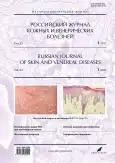Эффективность ингибитора IL-17А при генерализованном пустулёзном псориазе: клинический случай
- Авторы: Олисова О.Ю.1, Снарская Е.С.1, Кочергин Н.Г.1, Теплюк Н.П.1, Игнатьев Д.В.1, Тавитова А.Р.1, Махмуди В.1
-
Учреждения:
- Первый Московский государственный медицинский университет имени И.М. Сеченова (Сеченовский Университет)
- Выпуск: Том 25, № 1 (2022)
- Страницы: 73-83
- Раздел: ДЕРМАТОЛОГИЯ
- URL: https://journals.rcsi.science/1560-9588/article/view/105295
- DOI: https://doi.org/10.17816/dv105295
- ID: 105295
Цитировать
Аннотация
Представлен первый клинический случай эффективного применения отечественного биологического препарата ― ингибитора IL-17А нетакимаба ― у больного упорно прогрессирующим, торпидным к терапии генерализованным пустулёзным псориазом Цумбуша. Этот редкий системный дерматоз относится к тяжёлым формам псориаза, угрожающим жизни пациента и требующим проведения интенсивной терапии уже с первых часов проявления заболевания. Развитию пустулёзного псориаза может способствовать длительная терапия системными глюкокортикостероидами, цитостатиками, пероральными контрацептивами, а также длительное использование раздражающих наружных средств. В некоторых случаях заболевание связывают с высокими эмоциональными нагрузками, стрессами. При тяжёлом генерализованном пустулёзном псориазе эффективными оказываются биологические препараты, циклоспорин, метотрексат, ацитретин.
В статье представлены сводные данные об эффективности препаратов первой и второй линии в лечении пустулёзного псориаза. По данным литературы, пациенты с тяжёлым пустулёзным псориазом, торпидные к стандартной терапии, демонстрируют положительный ответ на лечение биологическими препаратами в большинстве случаев. Анти-TNF-α являются наиболее доступными биологическими препаратами для лечения пустулёзного псориаза, а анти-IL-12/23 и анти-IL-17A могут рассматриваться в качестве первой или второй линии терапии при умеренно тяжёлом и рефрактерном пустулёзном псориазе.
Выбор эффективной терапии для лечения пустулёзного псориаза является актуальной проблемой современной дерматологии. Представленный клинический случай демонстрирует эффективность применения ингибитора IL-17А и выраженный положительный терапевтический эффект уже в течение одних суток в лечении резистентного к ранее проводимой терапии генерализованного пустулёзного псориаза, что позволяет рассчитывать на перспективу дальнейшего успешного применения этого таргетного препарата.
Полный текст
Открыть статью на сайте журналаОб авторах
Ольга Юрьевна Олисова
Первый Московский государственный медицинский университет имени И.М. Сеченова (Сеченовский Университет)
Автор, ответственный за переписку.
Email: Olisovaolga@mail.ru
ORCID iD: 0000-0003-2482-1754
SPIN-код: 2500-7989
д.м.н., профессор
Россия, МоскваЕлена Сергеевна Снарская
Первый Московский государственный медицинский университет имени И.М. Сеченова (Сеченовский Университет)
Email: snarskaya-dok@mail.ru
ORCID iD: 0000-0002-7968-7663
SPIN-код: 3785-7859
д.м.н., профессор
Россия, МоскваНиколай Георгиевич Кочергин
Первый Московский государственный медицинский университет имени И.М. Сеченова (Сеченовский Университет)
Email: nkocha@yandex.ru
ORCID iD: 0000-0001-7136-4053
SPIN-код: 1403-3031
д.м.н., профессор
Россия, МоскваНаталия Павловна Теплюк
Первый Московский государственный медицинский университет имени И.М. Сеченова (Сеченовский Университет)
Email: teplyukn@gmail.com
ORCID iD: 0000-0002-5800-4800
SPIN-код: 8013-3256
д.м.н., профессор
Россия, МоскваДмитрий Владимирович Игнатьев
Первый Московский государственный медицинский университет имени И.М. Сеченова (Сеченовский Университет)
Email: dmitrywork@list.ru
ORCID iD: 0000-0001-8751-3965
SPIN-код: 6743-7960
Россия, Москва
Алана Руслановна Тавитова
Первый Московский государственный медицинский университет имени И.М. Сеченова (Сеченовский Университет)
Email: alatavitova@mail.ru
ORCID iD: 0000-0003-1930-0073
SPIN-код: 2113-9091
аспирант
Россия, МоскваВильям Махмуди
Первый Московский государственный медицинский университет имени И.М. Сеченова (Сеченовский Университет)
Email: dr.williamm@mail.ru
ORCID iD: 0000-0001-6075-411X
Россия, Москва
Список литературы
- Crowley J.J., Pariser D.M., Yamauchi P.S. A brief guide to pustular psoriasis for primary care providers // Postgrad Med. 2021. Vol. 133, N 3. P. 330–344. doi: 10.1080/00325481.2020.1831315
- Олисова О.Ю., Хобейш М.М., Знаменская Л.Ф., Бакулев А.Л. Федеральные клинические рекомендации по ведению больных псориазом. Москва, 2013. 68 с.
- Олисова О.Ю., Теплюк Н.П., Пинегин В.Б. Современные методы лечения псориаза // Русский медицинский журнал. 2015. Т. 23, № 9. C. 483–484.
- Boehner A., Navarini A.A., Eyerich K. Generalized pustular psoriasis ― a model disease for specific targeted immunotherapy, systematic review // Exp Dermatol. 2018. Vol. 27, N 10. P. 1067–1077. doi: 10.1111/exd.13699
- Johnston A., Xing X., Wolterink L., et al. IL-1 and IL-36 are dominant cytokines in generalized pustular psoriasis // J Allergy Clin Immunol. 2017. Vol. 140, N 1. P. 109–120. doi: 10.1016/j.jaci.2016.08.056
- Hoegler K.M., John A.M., Handler M.Z., Schwartz R.A. Generalized pustular psoriasis: a review and update on treatment // J Eur Acad Dermatol Venereol. 2018. Vol. 32, N 10. P. 1645–1651. doi: 10.1111/jdv.14949
- Wang W.M., Jin H.Z. Biologics in the treatment of pustular psoriasis // Expert Opin Drug Saf. 2020. Vol. 19, N 8. P. 969–980. doi: 10.1080/14740338.2020.1785427
- Genovese G., Moltrasio C., Cassano N., et al. Pustular psoriasis: from pathophysiology to treatment // Biomedicines. 2021. Vol. 9, N 12. P. 1746. doi: 10.3390/biomedicines9121746
- Gooderham M.J., van Voorhees A.S., Lebwohl M.G. An update on generalized pustular psoriasis // Expert Rev Clin Immunol. 2019. Vol. 15, N 9. P. 907–919. doi: 10.1080/1744666X.2019.1648209
- Ratnarajah K., Jfri A., Litvinov I.V., Netchiporouk E. Spesolimab: a novel treatment for pustular psoriasis // J Cutan Med Surg. 2020. Vol. 24, N 2. P. 199–200. doi: 10.1177/1203475419888862
- Komine M., Morita A. Generalized pustular psoriasis: current management status and unmet medical needs in Japan // Expert Rev Clin Immunol. 2021. Vol. 17, N 9. P. 1015–1027. doi: 10.1080/1744666X.2021.1961580
Дополнительные файлы










